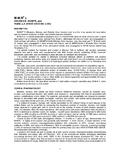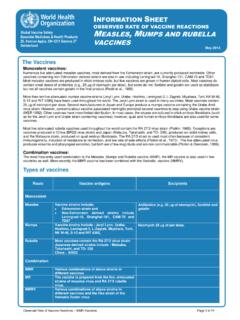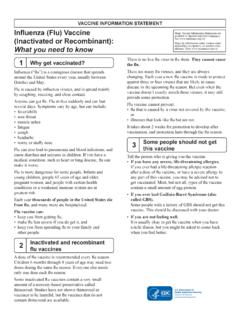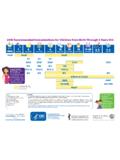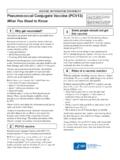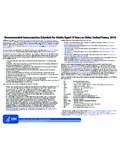Transcription of OBSERVED RATE OF VACCINE REACTIONS …
1 Global VACCINE Safety Essential Medicines & Health Products 20, Avenue Appia, CH-1211 Geneva 27 Switzerland s & Health Product The Vaccines Diphtheria and tetanus toxoids have been combined with pertussis antigens and used as a combination DTP VACCINE since the 1940s. More recently, this DTP combination has been used as the basis for the development of combination vaccines containing additional VACCINE antigens added singly or in additional combinations such as Haemophilus influenzae type b, hepatitis B and inactivated poliovirus, allowing multiple VACCINE antigens to be delivered via a single injection. In addition, in some DTP vaccines the diphtheria dose has been reduced and pertussis antigen has been modified to allow these vaccines to be used for booster doses in adolescents and adults. Because these toxoids and antigens are now frequently used as combined vaccines, most adverse events following immunization reported in these vaccines are likely due to the safety profile of their individual components.
2 VACCINE preparations: Multiple combination vaccines to prevent diphtheria, tetanus, and pertussis are in use globally and each has a specific composition. Understanding how the toxoid and antigen contents are standardised and recorded is important when comparing different combination vaccines. For diphtheria and tetanus the potency and amount of toxoid in a VACCINE are recorded in International Units (IU) and in Limits of Flocculation (Lf). Whole-cell pertussis vaccines are standardised using a mouse protection test. No simple methods exist for standardising the potency of acellular pertussis vaccines. DTP vaccines are available in various formulations and are given in mL doses. The five most common are DTwP, DTaP, Tdap, DT, and Td. Of these vaccines, three (DTwP, DTaP and DT) are given to children younger than 7 years of age, and two (Tdap and Td) are given to individuals 7 years or older. As indicated by the lower case "d" and "p", the concentration of diphtheria and pertussis toxoids has been reduced in these "adult" formulations to prevent adverse effects, while the "a" in "ap" indicates that the pertussis toxoids are acellular.
3 Composition of single antigen vaccines: Diphtheria toxoid - Diphtheria toxoid is prepared by formalin inactivation of diphtheria toxin. Usually it is available as a preparation adsorbed with aluminium hydroxide or phosphate and combined with other toxoids or VACCINE antigens. The potency of diphtheria VACCINE used for the immunization of children should not be less than 30 IU per single human dose, while for adults; the potency is about a third of the dose for children. Monovalent single antigen diphtheria toxoid is currently commercially unavailable. Tetanus toxoid - Tetanus toxoid is a preparation of formalin inactivated toxin. The toxoid is available adsorbed with aluminium phosphate or hydroxide, alone or in combination with other toxoids or vaccines. The potency of tetanus toxoid, expressed in International Units, varies widely according to the preparation and the manufacturer, but WHO stipulates the potency of tetanus VACCINE used for the immunization of children should not be less than 40 IU per single human dose.
4 The minimum potency specification for tetanus VACCINE intended for booster immunization of older children and adults may be lower and should be approved by the National Regulatory Authority (NRA). Single antigen adsorbed tetanus toxoid is available with a toxoid content of 2 to 10 Lf/dose. Pertussis antigens - Pertussis vaccines either contain antigens from the whole pertussis organism or a variable number of purified acellular component antigens. The whole-cell vaccines contain a suspension of killed B. pertussis organisms at a concentration of more than 4 IU. The acellular vaccines are made from purified antigens of Bordetella pertussis. All the current vaccines contain pertussis toxoid ( to 40 g per dose) and most contain filamentous agglutinin ( - g per dose). Additional antigens in these vaccines may include pertactin ( - g per dose), fimbriae 2 ( to 5 g per dose) and fimbriae 3 (5 g per dose), (CDC, 1997).
5 Currently no pertussis vaccines are available that contain a combination of less than 2 VACCINE antigens (Joyce, 1994). Composition of DTP vaccines: Although different combinations may contain the same toxoids or antigens each VACCINE may differ substantially according to the toxoid or antigen dose, number of pertussis components (for acellular vaccines), method of purification and inactivation of the toxins and incorporation of adjuvants and excipients. All of these factors may have an impact on the reactogenicity of different DTP VACCINE combinations. Diphtheria and Tetanus (DT and Td) toxoid combination: DT VACCINE used for primary immunisation and boosting in children contains of diphtheria toxoid and 5 Lf of tetanus toxoid per dose. An adult combination, Td, is used for boosting and primary immunisation in adolescents and adults and contains a lower dose of diphtheria (less than 2 Lf/dose) but a similar dose of tetanus toxoid.
6 INFORMATION SHEET OBSERVED RATE OF VACCINE REACTIONS DIPHTHERIA, PERTUSSIS, TETANUS VACCINES May 2014 OBSERVED Rate of VACCINE REACTIONS DTP VACCINE Page 1 of 10 Diphtheria, Tetanus and Pertussis (DTP) combinations: Initial DTP combination preparations contained whole-cell pertussis antigens. Concern due to common occurrence of minor local REACTIONS and less common severe REACTIONS of whole-cell pertussis led to the development of acellular vaccines and clinical trials demonstrating their efficacy in the 1980 s. Multiple acellular pertussis vaccines are now available and are referred to by the number of acellular antigen components that they contain. Whole-cell pertussis VACCINE remains a safe, inexpensive and effective VACCINE which is used in many countries because whole cell vaccines that generate a higher level of antibody to pertussis toxin are associated with higher VACCINE efficacy.
7 DTP with other VACCINE antigen combinations: There are many VACCINE formulations containing diphtheria and tetanus toxoids and whole cell or acellular pertussis antigens in combination with Haemophilus influenzae type b, hepatitis B and/or inactivated polio virus to produce quadrivalent, pentavalent and hexavalent combination vaccines. Adverse events Diphtheria toxoid vaccines Initial use of diphtheria toxoid, was associated with significant local and systemic REACTIONS but purifying the toxoid, adsorbing it on aluminium hydroxide enabled the reduction of the required toxoid dose. This decreased the frequency of such REACTIONS . (Vitek CR et al., 2008). However, comprehensive safety data for the currently used adsorbed preparation of diphtheria toxoid is limited since monovalent diphtheria VACCINE is seldom used. Most understanding about reactogenicity of diphtheria toxoid comes from comparisons between TT and TD/DT.
8 The frequency of REACTIONS was related to three factors: the degree of purity of diphtheria toxoid, the dose of antigen, the number of previous booster doses and spacing from previous dose. Even highly purified toxoid, free of all traces of impurities can result in undesirable REACTIONS in a high proportion of older immune persons probably related to hypersensitivity to diphtheria toxoid (Galazka et al., 1996), Systemic REACTIONS seen in 3-10% of vaccinees after a 2-5 Lf dose included malaise, headache, or fever. A 10 Lf dose of diphtheria toxoid given to adult health workers caused common severe REACTIONS (Butterworth et al 1974). REACTIONS were significantly correlated with the level of response to a booster dose. In persons with no adverse REACTIONS , the mean antitoxin level was IU per ml following a booster dose, compared with levels of IU per ml in persons with local REACTIONS , and IU per ml in those with systematic REACTIONS (Simonsen O et al.)
9 , 1986). Tetanus toxoid vaccines Mild local REACTIONS are common after tetanus toxoid; however more serious REACTIONS are rare. The rates and severity are influenced by the number of prior doses, level of pre-existing antitoxin, the type and quantity of adjuvant, the route of injection and the presence of other substances as preservatives. Mild adverse events The only data available is when the toxoid has been used as a booster dose in adults. Adults, primed with diphtheria in childhood and who received diphtheria VACCINE containing Lf of toxoid, commonly experience mild or moderate local REACTIONS (38%). However, severe pain at the injection site was reported in 20%. REACTIONS to adsorbed diphtheria toxoid are more frequent among people who have already received several booster doses (Edsall et al., 1954). Their frequency varies with the toxoid concentration and the level of anti-diphtheria toxin antibodies present in the blood prior to vaccination.
10 General symptoms (weakness of mild to moderate severity) was reported in 24% (Nahum et al., 1994 However, in a similar study using the same antigen content, but only including those individuals with a pre-vaccination antibody titre of less than , only 8% of subjects reported injection site pain. (Mortimer et al., 1986). Severe adverse events Severe adverse events solely attributable to diphtheria toxoid have not been documented. However, this relates in part to the current use of this antigen in combination vaccines and it is difficult to completely exclude diphtheria toxoid as being implicated in some of the rare severe adverse events following use of DTP combination vaccines. Mild adverse events Local REACTIONS are common and have been reported to occur in 50-80% of VACCINE recipients who receive a booster dose. These manifest as erythema, oedema and pain (Wassilak, 2008).)










